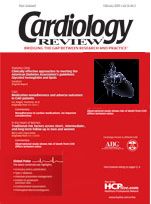High-dose better than low-dose atorvastatin in preventing events in stable CHD
ORLANDO—Aggressive lipid lowering using 80 mg/day of atorva-statin (Lipitor) prevents more major adverse cardiovascular events than 10 mg/day of atorvastatin in patients with stable coronary heart disease (CHD), said John LaRosa, MD, at the American College of Cardiology Annual Scientific Sessions 2005.
In reporting the results of the Treating to New Targets (TNT) study, Dr. LaRosa said that the reduction in cardiovascular risk with high- versus low-dose atorva-statin was “very robust” but that new guideline recommendations for lowering low-density lipoprotein (LDL) cholesterol for patients with stable CHD should await completion of other studies in progress. He did offer that the “link between LDL cholesterol and coronary heart disease is no longer disputed.”
In TNT, 10,001 patients with stable CHD and LDL cholesterol values of less than 130 mg/dL were randomly assigned to 10 or 80 mg/day of atorvastatin. The average exposure to treatment was 4.9 years, at which time patients assigned to 10 mg/day of atorvastatin achieved a mean LDL cholesterol level of 101 mg/dL and those assigned to 80 mg/day of atorvastatin achieved a mean LDL cholesterol of 77 mg/dL.
The primary end point—a composite of death from CHD, nonfatal myocardial infarction, resuscitation from cardiac arrest, or fatal or nonfatal stroke—was reduced by 22% (P = .0002) with high- versus low-dose atorvastatin. The outcome of stroke was reduced by 25% in the 80-mg/day group (P = .02).
There was no significant difference in mortality between the two groups, but the study was not sufficiently powered to compare the effect of the two doses on overall mortality, explained Dr. LaRosa, president, State University of New York Downstate Medical Center, Brooklyn. “We cannot with 10,000 people even answer the issue of mortality, and this is going to be a problem from now on in clinical trials in this area,” he said. “We have to make the assumption…that lowering LDL does lower the total mortality rate.”
The incidence of persistent elevations in liver enzyme levels was 0.2% in the group randomly assigned to 10 mg/day and 1.2% in the group assigned to 80 mg/day of atorvastatin (P < .001), “which is a fraction of the rate in other statin trials,” he said.
The incidence of persistent elevations in creatine kinase levels or complaints of myalgia did not differ between the two groups. Only five cases of rhabdomyolysis were reported, none of which the investigators attributed to the study drug.
Any change in the target levels of LDL cholesterol for patients with stable CHD should await the results of additional studies in which aggressive and moderate lipid lowering are compared, which are expected to be completed soon, said Dr. LaRosa. “We would be on firmer ground if we waited,” he said. “We already have an option to go to 70 [mg/dL].” In 2004, the Adult Treatment Panel (ATP) of the National Cholesterol Education Program issued an update to ATP III guidelines in which an option to achieve a more aggressive LDL cholesterol—70 mg/dL—was offered at the discretion of the treating physician.
